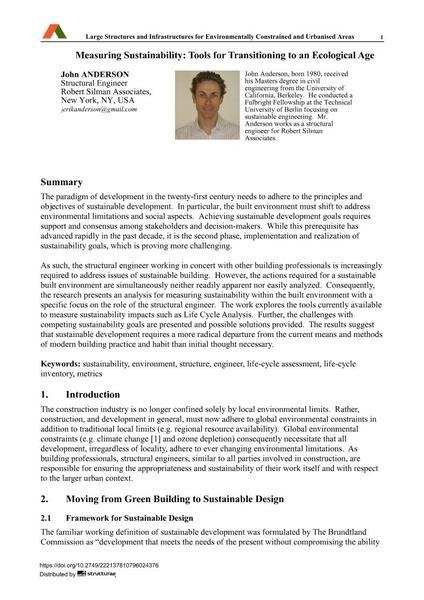Measuring Sustainability: Tools for Transitioning to an Ecological Age

|
|
|||||||||||
Bibliographic Details
| Author(s): |
John Anderson
|
||||
|---|---|---|---|---|---|
| Medium: | conference paper | ||||
| Language(s): | English | ||||
| Conference: | IABSE Symposium: Large Structures and Infrastructures for Environmentally Constrained and Urbanised Areas, Venice, Italy, 22-24 September 2010 | ||||
| Published in: | IABSE Symposium Venice 2010 | ||||
|
|||||
| Page(s): | 238-239 | ||||
| Total no. of pages: | 6 | ||||
| Year: | 2010 | ||||
| DOI: | 10.2749/222137810796024376 | ||||
| Abstract: |
The paradigm of development in the twenty-first century needs to adhere to the principles and objectives of sustainable development. In particular, the built environment must shift to address environmental limitations and social aspects. Achieving sustainable development goals requires support and consensus among stakeholders and decision-makers. While this prerequisite has advanced rapidly in the past decade, it is the second phase, implementation and realization of sustainability goals, which is proving more challenging. As such, the structural engineer working in concert with other building professionals is increasingly required to address issues of sustainable building. However, the actions required for a sustainable built environment are simultaneously neither readily apparent nor easily analyzed. Consequently, the research presents an analysis for measuring sustainability within the built environment with a specific focus on the role of the structural engineer. The work explores the tools currently available to measure sustainability impacts such as Life Cycle Analysis. Further, the challenges with competing sustainability goals are presented and possible solutions provided. The results suggest that sustainable development requires a more radical departure from the current means and methods of modern building practice and habit than initial thought necessary. |
||||
| Keywords: |
sustainability structure environment engineer life-cycle assessment life-cycle inventory metrics
|
||||
